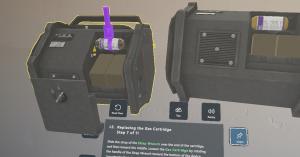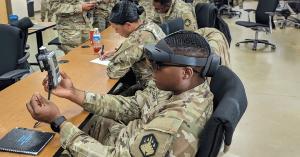Augmented Reality Simulators to Enhance Warfare Training for The Joint Project Lead for Chemical, Biological, Radiological and Nuclear Special Operations Forces
— Greg Meyers
SAN FRANCISCO, CALIFORNIA, UNITED STATES, November 22, 2022 /EINPresswire.com/ — ForgeFX Simulations and MRIGlobal have partnered to develop of a suite of augmented reality device training simulators for the Joint Project Lead for Chemical, Biological, Radiological, and Nuclear Special Operations Forces (JPL CBRN SOF). Created for the Microsoft HoloLens 2, the CBRND HoloTrainer instructs trainees in the familiarization, operation, and maintenance of CBRN devices by providing holographically-projected interactive 3D virtual versions of the equipment they need to learn to use.
The CBRND HoloTrainer includes comprehensive training for several CBRN detection devices which locate and analyze chemical, biological, radiological, and nuclear hazards. For each device training module, the application supplies two virtual models. One model is used as a reference for demonstration purposes—virtually displaying the correct actions and steps that need to be performed. The second model allows the user to interact and practice these actions.
Additionally, if a trainee has access to a real-world device, they can conduct these actions on the physical device while learning from the virtual reference model. This allows the simulator to provide training to trainees whether or not they have access to a physical device. While working with the interactive virtual models, the trainee is guided by textual information, audio narration, animation, and sound effects. By providing these multiple levels of instruction to the user, we ensure that the necessary information is being conveyed in a format that works with their style of learning.
In addition to single-user mode, the augmented reality training simulators supports a networked multiuser mode, allowing several people to connect to the simulation session regardless of their physical location. Even though users may be on opposite ends of the planet, they can work together collectively on the same virtual device as if they were standing in the same room. This support for multiuser helps overcome the challenges and costs of conducting training in the real-world associated with travel. Furthermore, users can use the simulator to quickly connect with subject matter experts while in the field to ensure they are using the device correctly—an invaluable advantage when conducting mission-critical exercises.
Because there is so little room for error when working with hazardous materials, the training simulator must provide the highest level of training available. By deploying the application on the Microsoft HoloLens 2, users can virtually get their hands on digital twins of the devices they’ll be required to operate during mission-critical activities.
Taking simulation-based training into the third dimension and presenting it as holographically-projected interactive virtual content allows users to interact with the subject material in a way never before possible, increasing their participation and involvement to deliver highly impactful training while reducing the risks associated with working with hazardous substances.
One of the first sensors to be chosen for simulation, 908 Devices’ MX908, is a handheld mass spectrometer with a high degree of sensitivity. The CBRND HoloTrainer familiarization lessons instruct the user on taking samples of chemical, explosive, drug, and hazmat contaminants; and in how to read the spectrometer analysis of the substances. One of the key benefits of virtual training is the much-reduced risk of physical harm to the trainees; another is reduction in cost of consumable or disposable items such as swabs, caps, and pens.
For more information: https://www.forgefx.com/
###
Greg Meyers
ForgeFX Simulations
+1 415-788-5725
info@forgefx.com
Visit us on social media:
Facebook
Twitter
LinkedIn
Other
CBRND HoloTrainer, Augmented Reality Device Training Simulators for Enhanced Warfare Training
![]()























